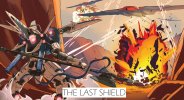Coin
world's okayest lobotomite (they/them)

Art by Peyton Gee
- - -
-THE END-
In the year 2028, a previously unobserved mass cluster the size of a large metropolitan city was discovered by satellite observation arrays to be in direct collision course with Earth. An object of its size and velocity was predicted to result in certain extinction for all life on the pale blue dot. This object was given the designation Object Tartarus. In response to this imminent threat to mankind, Emergency Measure 3811 was enacted by the United Nations Security Council to divert at least 30% of the Security Council's defense spending towards the research and development of a countermeasure against Object Tartarus.
By 2029, the United States had indefinitely suspended its air campaign against Iran and its proxies, the Russian Armed Forces had retreated its forces back to the pre-2022 border with Ukraine in the Third Minsk Agreement, and the People's Republic of China's invasion fleet had been mothballed. The groundwork for an Arctic facility also began that would be the site of an array of counter-impact rail cannons that would stand as Earth's defense against Object Tartarus. This array would be known as DOLMEN, and would be completed in collaboration with 127 member countries of the United Nation in October of 2031 -- a mere month before projected impact of Object Tartarus. Those participating in humankind's greatest collaborative effort would be organized under the newly created United Nations Unified Command, an emergency commission created solely for the preservation of mankind at all costs.
DOLMEN would deliver its first barrage shortly after its completion. Hyperdense depleted uranium sabots 100 meters in length would be accelerated towards Object Tartarus at 1/10th of light speed thanks to a breakthrough advance in mass inversion technology. In all, this barrage would consist of 128 projectiles, all calculated to impact Object Tartarus at predetermined locations within a 75 millisecond window. With enough luck, this would fragment Object Tartarus into a shower of smaller, more manageable pieces.
Nearly a week after the first barrage, a second barrage would be prepared to fire as soon as first would impact. The world stood still as everyone waited for the Security Council to deliver a statement of DOLMEN's success or failure.
At first, the operation seemed successful. Object Tartarus had splintered into hundreds of sub-objects, each with the capacity to deal significant harm to Earth, but no longer presented an existential threat to mankind. Billions cheered as DOLMEN prepared to fire again, another strike to deliver a salvo of 128 thermonuclear warheads that would vaporize the sub-objects and end the threat of Tartarus once and for all. However, something that defied the collective calculations of Earth's brightest minds occurred before the second salvo could make impact. It appeared that the sub-objects *evaded* the warheads that followed. Of 128 warheads, only 38 detonated within proximity of any of the Tartarus sub-objects. There was no time left for a third barrage from DOLMEN. Instead, slow, repurposed ICBMs would be used to provide the last line of defense.
Mankind was still in mortal danger, as these ICBMs could only hope to saturate the sub-objects in their overlapping blast radii. None had the velocity or agility to directly intercept the individual sub-objects of Tartarus' debris field. In November of 2031, the first ICBMs were launched beyond Earths orbit and hundreds of millions fled from projected impact sites. Storms of nuclear inferno painted the skies above Earth's orbit for days, but Unified Command's efforts could not bring an end to the coming apocalypse.
A vast majority of the Tartarus' sub-objects fell upon the northern hemisphere. It's unknown how many perished in the initial strikes, but conservative calculations predict the number to be 4 billion, or half of all people in the northern hemisphere. The many people and languages called this cataclysm countless things: Armageddon, Judgement Day, or Ragnarök, though one would be synonymous to all. The Starfall.
-THE STARFALLEN-
It didn't take long for reports from Starfall impact sites to reach the survivors. Not only had Tartarus' debris wiped innumerable souls from existence in the blink of an eye, but a worse yet threat had emerged from the molten craters that were once cities and towns. Millions of biomechanical extraterrestrial beings that towered over mankind, ranging from a few meters tall to hundreds of meters tall poured out of the wasteland they had created upon their arrival. Unified Command's worst fears had become realized -- the debris of Object Tartarus had not been debris after all, they were invasion ships.
The Starfallen, as they were dubbed, act in a eusocial manner not dissimilar to the hymenopteran order of ants, wasps, and bees. Each individual being serves a higher function in the Starfallen hierarchy. Their biology is certainly alien in origin, with most having trunk-like ambulatory limbs and tentacle-like or pincer-like manipulation limbs. The larger, more complex Starfallen are also supplemented with poorly understood biomechanical technology that have the closest analogues as cannons, shields, and hormone regulators.
Every type of Starfallen seem to be hyperaggressive towards life on Earth, seeking to kill and even devour victims. Initial attempts to engage in diplomacy or even communication with the Starfallen have ended in catastrophe. The overwhelming swarm-like nature of the Starfallen combined with their poorly understood technology and even more poorly understood motives led to Unified Command's near collapse as city after city fell to this new threat. Line after line was broken. Washington, London, Paris, Berlin, Moscow, Beijing, Tokyo would all capitulate in weeks, if not days under the weight of the Starfallen invasion. With so much of Earth's thermonuclear stockpile deployed against the Tartarus sub-objects, only lower-yield tactical nuclear devices remained to combat the horde. Though effective, they were not nearly enough to stop the onslaught.
-EXO TACTICAL ARMOR (ETA)-
Fields of landmines would be cleared in hours by Drone-type Starfallen. Cluster munitions could only create diminutive gaps in the Starfallen lines. Conventional warships, tanks, infantry-fighting vehicles, and static artillery stood no chance as their lack of mobility could not keep up with constantly shifting masses of Starfallen. The old ways of conventional warfare did not work against this previously unimaginable threat. The Tidal Research and Development Group, a conglomeration of many of pre-Starfall's largest defense industrial corporations were the first to offer a solution to the Starfallen threat. The T-1 Exo Tactical Armor was a bipedal combat armor suit that stood at 9 meters tall. It offered the remnants of Earth's militaries a machine that balanced high mobility in many environments and a suite of interchangeable weapon platforms that could be adopted for many types of combat operations. Though its armored protection and pilot recovery systems left much to be desired, it was the first purpose-built machine that excelled in combating the Starfallen.
The first deployment of the T-1 ETA was at the Battle of Hong Kong, where Unified Command dispatched the 1st, 9th, and 21st Strike Divisions consisting 648 T-1s to the city from the South China Sea Carrier Group to retaliate against the Starfallen encirclement. Success came in the form of the destruction of all three Citadel-type Starfallen fortresses that surrounded Hong Kong, temporarily lifting the siege. Though only 25% of the total dispatched T-1s would return to the carrier group, it was the first time Unified Command had earned a decisive victory against the Starfallen. From this point on, ETA development, production, and tactics would be the focus of Unified Command's resources.
-THE ARES PROGRAM, PRESENT DAY, AND YOU-
The year is now 2037, six years after Starfall, and mankind has begun to slowly grind back and hold fast against the Starfallen. With the help of the ETAs, mankind's certain destruction had been temporarily halted, but at great cost. The average life expectancy of an ETA pilot is three frontline sorties against the Starfallen -- or an average of 90 minutes of direct combat. Those that make it past this phase are considered veterans, or just lucky. It is estimated that the number of ETA pilots considered 200 (KIA) or MIA number in the tens of thousands. Rightfully so, the ETA pilot and their maintenance crews are considered the saviors of humanity.
An ETA pilot that has survived and conducted operations favorably in at least nine frontline sorties against the Starfallen are called Wonder 9s. These pilots that have shown exceptional skill and prowess are given the choice (or sometimes voluntold) to enter a program for the elite: the ARES Program -- Advanced Response Enhancement Systems. Elite training programs and invasive cybernetic surgeries are hallmarks of the program, the most drastic of which is called the Shell. This surgery applies an electromechanical subdermal interface to the pilot, allowing them near-direct connection with their ETA at the price of feeling real pain upon their machine receiving damage. This pain is a small price to pay for the survival of mankind.
Your character will be a new inductee to the ARES Program. Your character will (likely) have survived to become a Wonder 9, and will have undergone (and survived) the ARES gauntlet of surgeries. Now, they have been assigned to class 2037F at the world-renowned Special Tactical Armor School where they will enjoy benefits such as learning under the best pilots Unified Command has to offer, access to cutting edge ETA technology, and access to meals with real meat once every two weeks instead of once a month.
Welcome, Cadet!
Last edited:





